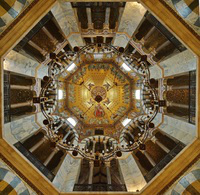Speaker
Description
The Borexino liquid scintillator neutrino observatory is devoted to perform high- precision neutrino observations, and it is optimized for measurements in the low energy (sub- MeV) region of the neutrino spectrum. The direct measurements, already accomplished, of the interaction rates from pp, 7Be, pep, 8B neutrinos put Borexino in the unique situation of being the only experiment able to validate the MSW-LMA oscillation paradigm across the full solar energy range. Very recently, high-precision determinations (down to ~2.8% in the 7Be component) have been attained using new techniques and enlarged statistics from the post-scintillator-purification phase.
The exceptional radiopurity is the key to the uniqueness of the detector’s results and the base for providing good sensitivity to faint signals such as the ones induced by geo-neutrinos, the antineutrinos released in the decays of radioactive elements distributed through the Earth. The geo-neutrino fluxes, detected by Borexino with a statistical significance of 5.9σ, are in a well-fixed ratio with the total mass of radioactive elements inside the Earth, thus, it is possible to extract geological information unreachable by other means and fundamental to understand the Earth’s heat balance.
The present talk is aimed to present results achieved by Borexino on geo-neutrinos fluxes and on all the solar neutrino species and based on the full 10 years data sample and, in particular, on the more radiopure phase 2 data, taken after the detector purification campaigns in 2010-11. In the solar neutrino analysis, a new multivariate method has been developed to extend the data fitting procedure over a broad energy range and to contemporary extract the different solar neutrino components. The new results will be helpful to constrain the solar metallicity and to validate MSW-LMA paradigm and to explore the upturn energy region where the effect of possible not standard interactions could be exposed. The talk will be concluded highlighting the perspectives for the final stage of the solar program of the experiment, centered on the goal to fully complete the solar spectroscopy with the missing piece of the CNO neutrinos.




